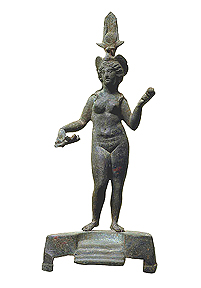
Roman, 1st century CE
From the coastal Levant
Bronze
Height: 22 cm
Width: 8.5 cm
Acquisition number: #ANE 134875
Image courtesy of the British Museum (copyright reserved)
Astarte, a fertility goddess worshipped in Syria and Palestine since ancient times, is depicted in this bronze statue modeled on classical sources. The Greeks associated Astarte with their own Aphrodite, the goddess of love, who was often symbolized by a dove. This image references this association by including a dove in the goddess's headdress, which in turn supports a horned sun disk, symbol of the Egyptian goddess Isis. Two tall feathers are also incorporated into the headdress design, an iconographic feature that identifies the goddess as a manifestation of Astarte known as Ba'alat Gebal, a Phoenician name meaning "the Goddess of Byblos."1
The Levant was taken from the Seleucid Empire by the Romans, who incorporated it into the province of Syria under Pompey. The Seleucids were ethnic Greeks who clung to their cultural heritage throughout their centuries of rulership of the Near East. When Syria became part of the Roman Empire, the social class structure remained relatively unaffected by the change in power, and the wealthy upper class culture continued to be dominated by Greek manners and customs. Even sculptures depicting local deities continued to respect classical poses, proportions and other design features. This preponderance of Hellenistic influences would also have met the approval of the Romans, who also relied heavily on the Greek cultural model.
(1) See the British Museum web page dedicated to this object.